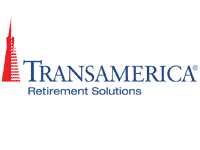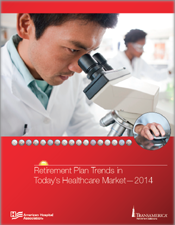Resource:
Executive Summary: Retirement Plan Trends in Today's Healthcare Market - 2014
Comprehensive benchmarking information to help the strategic evaluation of your retirement programs.
About the Survey
Retirement Plan Trends in Today’s Healthcare Market—2014 is the eleventh annual study conducted by Transamerica Retirement Solutions and the American Hospital Association. The study presents insight on current issues that impact defined contribution and defined benefit plans in the healthcare market. The report provides analysis to guide healthcare plan sponsors and their advisors as they benchmark their organizations in many areas of plan design and management, in order to critically evaluate opportunities for improvement.
The survey was comprised of 90 questions and was conducted online at the end of 2013. A total of 104 hospital administrators and chief financial officers responded to the survey, representing healthcare organizations with one or more active defined contribution plans..
Executive Summary
Healthcare plan sponsors understand the critical need to help plan participants prepare financially for retirement, and the survey Retirement Plan Trends in Today’s Healthcare Market—2014 shows that plan sponsors are becoming increasingly more proactive in meeting this challenge. According to the survey, the majority of healthcare plan sponsors now consider the primary goal of their plans to be helping employees accumulate income for retirement. When gauging the success of their plan, a growing percentage of healthcare plan sponsors use retirement readiness measures such as deferral rates and participants being on course to meet their goals. While participation rate is still the most common benchmark, use of this indicator as the primary measure of plan success declined significantly.
“Motivating employees to save adequately” and “helping participants to invest wisely” were cited as primary plan challenges more often than administrative challenges such as managing workloads, keeping up with regulatory changes, and meeting fiduciary responsibilities.
Healthcare plan sponsors are taking proactive steps to address the plan challenges that they identified by holding and encouraging attendance at employee meetings. Use of educational videos is on the rise and more healthcare plan sponsors are tailoring educational materials to specific employee groups.
Forty percent of healthcare plan sponsors surveyed use automatic features such as automatic enrollment and automatic escalation of deferral amount to help drive participants toward retirement readiness. However, utilization of these automatic features did not increase over the last two years.
In those surveyed plans that do use automatic features, default deferral rates are trending up significantly. Utilization of a 3% default deferral rate, while still the most common default rate, declined markedly, while utilization of a 4% default rate increased considerably, and use of a 5% default rate nearly quadrupled. And yet, nearly nine in ten healthcare plan sponsors indicated they do not feel their default deferral rates are high enough for participants to achieve a fully funded retirement.
Three-quarters of healthcare plan sponsors surveyed offer a 403(b) plan and 40% offer a 401(k) plan. Usage of Roth 403(b) increased slightly, and usage of Roth 401(k) remained steady. Most sponsors employ a single vendor arrangement, and there is emerging stability in vendor arrangements as fewer healthcare plan sponsors added or replaced a plan vendor.
More healthcare plan sponsors surveyed impose a minimum age requirement for plan entry, and fewer impose an age requirement for employer contributions. When utilized, the most common age requirement—for plan entry as well as employer contributions—is age 18. Over half of healthcare plan sponsors allow participation in the plan immediately upon employment, but far fewer provide employer contributions without a service requirement. When a service requirement is imposed, the most common service requirement—for both plan entry and employer contributions—is three months to one year.
Nearly all healthcare plans surveyed provide an employer contribution. A fixed contribution, while still the most common type offered, decreased significantly in frequency, while the offering of a discretionary contribution increased. A matching contribution remains the most common type of fixed employer contribution provided, but this decreased notably, while a stated percent of salary as the type of fixed contribution offered increased correspondingly. More plans with discretionary employer contributions and fewer plans with matching contributions may not bode well for the unilateral effort across the retirement industry to increase deferral rates by encouraging participants to contribute at least enough to maximize their employer’s matching contribution.
More positively, although the most common stated percent of salary offered as an employer contribution continues to be 3%, the trend among those surveyed for offering 5% is up. Furthermore, several of the most common employer match formulas show a significant increase in the level of the match provided. In fact, the frequency of plans offering $.50 up to 6% of pay or higher nearly doubled since 2012. While the decrease in frequency of plans that offer a matching contribution (versus an increase in frequency of plans that offer a stated percentage) is a concern that will be monitored, the increase in level and amount of the employer match—in plans that do offer this type of employer contribution—speaks very well for healthcare plan sponsors' efforts to drive participants’ financial preparedness for retirement.
Healthcare plan sponsors appear to be streamlining their investment arrays as the trend for offering 20+ funds is decidedly down, according to the survey. The number of proprietary funds available declined as well.
Overall participation rates and deferral rates have remained fairly constant over the past two years—except for default deferral rates in plans that utilize automatic enrollment, which have increased. Drawdown of retirement account balances through loans and hardship withdrawals is always a concern from a retirement preparedness perspective. Over 10% of plan participants have an outstanding loan, and the average hardship withdrawal amount has increased. Utilization of outsourcing arrangements for defined contribution healthcare plans surveyed is trending up for nearly every plan service function including loans, hardship withdrawals, QDROs, and enrollment.
Less than half of healthcare plan sponsors surveyed offer a defined benefit plan. A traditional defined benefit plan is offered more often than a cash balance or other hybrid plan. Only 25% of defined benefit healthcare plans are active. About a third are frozen to new employees, and another third are frozen to all employees.
Defined benefit healthcare plan sponsors are shifting away from unbundled and semi-bundled service arrangements. Conversely, while only a quarter of healthcare plan sponsors employ a fully bundled approach, utilization has increased considerably over the past two years.
Funding levels are markedly up among those surveyed. Nearly six in ten defined benefit healthcare plan sponsors report a funding level of 91% or higher. Nearly one-third of healthcare plan sponsors anticipate making a change to their defined benefit plans, and the most common expected changes are hiring a consultant to develop a strategy for the plan and/or freezing or terminating the plan. Total Retirement Outsourcing—defined as the outsourcing of all administrative functions for all of the organization’s retirement plans—is utilized by a quarter of all healthcare plan sponsors. Over half of healthcare plan sponsors have not considered Total Retirement Outsourcing.
About half of healthcare plan sponsors surveyed utilize the services of an onsite representative, who is most often responsible for meeting one-on-one with employees to help them understand the plan and improve their retirement readiness.
More than seven in ten healthcare plan sponsors surveyed partner with an intermediary. This intermediary is most often an investment advisor or securities broker, or investment or benefits consultant, who works primarily with retirement plans. Typically the advisors are responsible for reviewing investment options, explaining provider fees, supporting due diligence, and formulating the investment policy statement. Over a third of healthcare plan sponsors surveyed have recently experienced a merger or acquisition, and just over 40% of the merged/acquired organizations utilized an advisor at the time of the merger.
The Retirement Plan Trends in Today’s Healthcare Market—2014 survey presents thoughtful and detailed analysis of the complex and ever-evolving healthcare retirement market. The insight and details that follow in this report are intended to help plan sponsors and their advisors interpret current trends in the healthcare market, so that they can compare their own plans to industry benchmarks and identify opportunities for improvements that will help their employees achieve a fully funded retirement.
AHA Solutions, Inc.
AHA Solutions, Inc. is a resource for hospitals that are pursuing operational excellence. As an American Hospital Association (AHA) member service, AHA Solutions collaborates with hospital leaders and market consultants to conduct product due diligence and identify solutions to hospital challenges in several operational areas including finance, human resources, patient flow, and technology. AHA Solutions provides related marketplace analytics and education to support product decision-making. As a subsidiary of the AHA, the organization convenes people with a similar interest in knowledge-sharing centered on timely information and research. AHA Solutions is proud to reinvest its profits in the AHA mission: creating healthier communities. For more information, contact AHA Solutions at 800.242.4677 or visit www.aha-solutions.org.
American Hospital Association
The American Hospital Association (AHA) is a not-for-profit association of healthcare providers and individuals who are committed to health improvement in their communities. The AHA is a national advocate for its members, which include more than 5,000 hospitals, health systems and other healthcare organizations, and 42,000 individual members. Founded in 1898, the AHA provides education for healthcare leaders and is a source of information on healthcare issues and trends. For more information, visit www.aha.org.
About Transamerica Retirement Solutions
Transamerica Retirement Solutions (Transamerica) has been serving the healthcare market since 1963 and is a leading provider of customized retirement plan solutions for small- to large-sized organizations.
Transamerica partners with financial advisors, third-party administrators, and consultants to cover the entire spectrum of defined benefit and defined contribution plans, including: 401(k) and 403(b) (Traditional and Roth); 457; profit sharing; money purchase; cash balance; Taft-Hartley; multiple employer plans; nonqualified deferred compensation; and rollover and Roth IRA. Transamerica helps more than three million retirement plan participants save and invest wisely to secure their retirement dreams. For more information about Transamerica Retirement Solutions Corporation, please visit www.trsretire.com.
Market Intelligence
We are dedicated to:
- Presenting a comprehensive picture of the private retirement plans market.
- Providing plan sponsors and advisors with comprehensive, actionable benchmarking information.
- Analyzing trends to assist with the strategic evaluation of retirement plans. Drawing on 75 years of experience in retirement plans management, we periodically assemble experts from all facets of the retirement plans business to evaluate the current and future impact of trends shaping the industry.
To request a copy of the full Retirement Plan Trends in Today’s Healthcare Market—2012 report, contact your Transamerica representative or email MarketInsights@transamerica.com.

